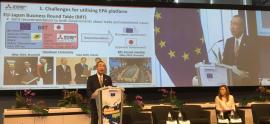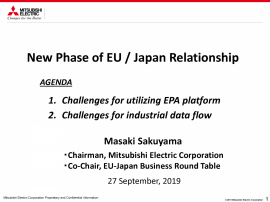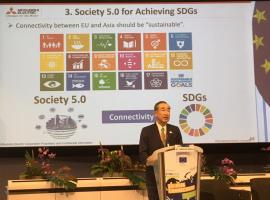
BRT at the 2019 EU-Asia Connectivity Forum
On 27 September 2019, the European Commission organised an EU-Asia Connectivity Forum - Building Bridges for a Sustainable Future. The event was opened by European Commission President Juncker and PM Abe of Japan, they also signed a Partnership on Sustainable Connectivity and Quality Infrastructure between the European Union and Japan.
Masaki Sakuyama, co-Chairman of the EU-Japan Business Round Table (or "BRT"), and Chairman of Mitsubishi Electric Corporation, was invited to deliver the keynote address for a session entitled, "The Standards and Norms of Connectivity". A recording of his keynote address is available, please click on "Keynote by Mr Sakuyama" or go to 14:34:50 in the recording.
 |
 |
 |
| click on the image to view his slides |
Mr Sakuyama addressed two aspects necessary for realising connectivity:
The challenges of utilising the EPA platform
Mr Sakuyama became BRT co-Chairman in April 2018. That July, he was able to attend the historic signing ceremony for the EU-Japan EPA and SPA. In May 2019, he co-Chaired the BRT's annual meeting in Brussels. The BRT is an EU-Japan public-private-partnership with its members and many government officials attending its annual meetings.
In May, the BRT made it clear that the EU-Japan EPA holds great promise, whilst recognising that it and the SPA are just the starting point with challenges remaining if we are to deepen EU-Japan cooperation. Two such challenges are:
1) Making the most of the EPA and turning it into economic vitality. Increased exports and tariff reductions are merely one benefit of the EPA. The EU and Japan must go 'beyond the EPA' and cooperate in a wide range of areas such as connectivity, green, digital economy, SDGs, investment and innovation. The BRT welcomes the reaffirmation of the importance of quality infrastructure investment and 6 principles to achieve it, by June's Osaka G20 Summit. The BRT looks forward to discussing third-country investment by strengthening connectivity through development of quality infrastructure, to create economic growth and social stability in the EU and Asia. The BRT will actively consider how best the EPA can be used as a flexible and wide-ranging platform.
2) Creating new regulations and standards from an early stage. If we are to deepen EU-Asia connectivity, we must not only align existing regulations and interfaces in each country. Instead, we should coordinate from the outset, on new policies and regulations in areas such as AI and autonomous driving. The BRT sees regulatory cooperation as an effective framework for this purpose. The EPA has established an EU-Japan regulatory cooperation committee. The BRT looks forward to actively participating in these discussions to make the framework function.
The challenges of realising industrial data flow
Digitalisation of the economy is an irreversible trend everywhere. Rapid innovation in AI and IoT technology has led to an explosion in the volume of data – an increasingly valuable source of industrial competitiveness. In January, at Davos, PM Abe noted that the engine for growth is fuelled no longer by gasoline, but increasingly by digital data.
There are two main types of data – personal and industrial data. The EU's GDPR, Japan's Act on the Protection of Personal Information and the linking Adequacy Decision address personal data. Given that digital technology is developing day by day, it is not difficult to imagine that the competition over industrial data will start sooner rather than later. Currently there are fewer regulations over this kind of data than over personal data.
Mr Sakuyama addressed some of the challenges to improve EU-Asia connectivity from the perspective of industrial data: Mitsubishi Electric's e-F@ctory IoT solution for industry optimises manufacturing by connecting devices and factories and analysing data.
He identified 4 ways of processing industrial data:
1) Collecting and visualising data with automation for a single company/factory – most companies are at this step.
2) Collecting and analysing data from different manufacturers' machines through 'Edge' platforms - they bring data closer to the user (e.g. Japan's Edgecross Consortium and FIELD system, or Europe's MindSphere).
3) Linking these platforms – to succeed, public-private cooperation will be necessary. Mr Sakuyama hoped that this cooperation could be expanded across the EU and Asia as this will enable data to flow across companies, industries, borders and continents. Last year, METI launched a contest in this area.
4) Regulatory alliances – this is what industry hopes governments will agree, ensuring data is handled fairly and safely – guaranteeing cybersecurity and preventing both the monopolisation of data by a few companies and data localisation requirements. The G20 Osaka Track to achieve data free-flow with trust is welcome.
The shift for industry from the current stage of utilisation of data to one of data flow across countries and regions will lead to innovation in the EU and Asian countries concerned, further deepening EU-Asia connectivity.
In his concluding remarks Mr Sakuyama pointed out that inter-government and international cooperation to make EU-Asia connectivity more meaningful will be a win-win. Echoing what both President Juncker and PM Abe said when opening the Forum, he underlined that EU-Asia connectivity must be sustainable.
Japan – like Europe – faces various challenges such as a declining birth rate, an ageing population, regional depopulation, and a widening gap between rich and poor, and is trying to tackle these social issues by making full use of the latest technologies such as IoT and AI. "Society 5.0" is a super-smart society that will succeed the current information society. It should be realised c. 2030. This notion of a human-centred future society was discussed at the G20 Summit in Osaka.
But if we are to realise Society 5.0, we must ensure sustainability - it is essential for promoting quality infrastructure investment and industrial data flow. To deepen EU-Asia connectivity, Mr Sakuyama emphasised that government and industry should cooperate closely whilst paying careful attention to connectivity with the SDGs.









